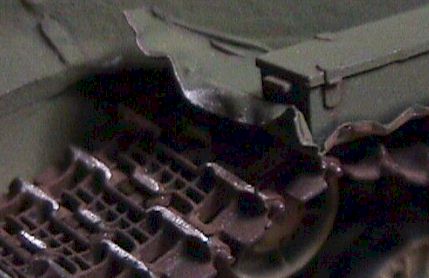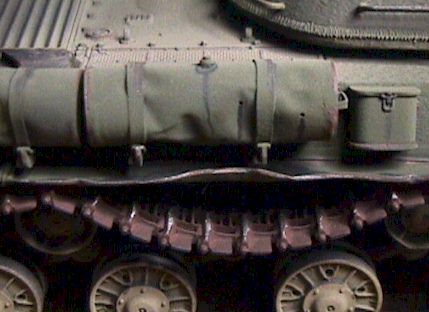Dragon kit built with modifications
by Anders Isaksson
based on model description by Valter Turkalj
By 1942, the Soviet high command realized the need for new heavy tanks of extreme firepower. With the experience from the KV line of heavy tanks, the Soviets started to build a new type called JS after generalissimus Josef Stalin. The appearance of the German heavy Tigers on the Eastern Front played a direct and decisive role in increasing the speed of development of these new models. The suspension was taken from an earlier prototype heavy tank (the T-100) and was quite similar to the earlier KV. The Christie-type torsion bar suspension was mounted higher in the hull, reducing the tank’s ability to negotiate obstacles but also decreasing it’s overall height and allowing the installation of a larger turret.
First model of the series, the JS-1 finished in mid-1943 was initially armed with 85mm cannon. Soon, the tank was up-gunned to 100mm and then 122mm resulting in the JS-2. The new tank had its operational debut late in 1943. By February 1944, all heavy breakthrough tank regiments were re-equipped with the new vehicles. At that time, it reanked among the best tanks in the world. With the gun capable of penetrating 160mm of armor at 1000m, it was more than capable of taking on heavy German tanks such as the Panther and Tiger, and was on fairly even terms with the King Tiger, although it was outweighed more than 20 tons by the latter.
JS-2 became the major production model and over 2 200 were built. In the early part of 1945 a further redesign was done, resulting in the JS-3 model. This was considerably different to the earlier versions and reflected combat experience. The whole tank was lowered and the armour of hull and turret were severely sloped to maximum shot deflection. While it never made an appearance during the war, the JS- 3 made its debut during the V-E day parade in Berlin. This tank, with its heavy gun, thick armor, and streamlined shape, set the standard for post-war armor.
The model
This model by Valter Turkalj is based on the Dragon kit of the JS-2 model 1943. Despite the years that passed since the introduction of this kit in 1994, the surface can still be described as exquisite. Cast texture, weld beads, bolts and hinges are all there. There are no sink marks or ejector pin marks in obvious and/or difficult locations. Major parts fit well with only a little need for filler.
No major modifications of the kit’s shape were required. Instead, Valter replaced a few parts with aftermarket or scratchbuilt items. The excess of the modification can be seen on the in-progress photo.
The replacement barrel is turned from aluminium and comes from Jordi Rubio. Valter decided to retain the kit’s muzzle brake since it featured superior surface detail.
The individual track links and drive sprockets are metal items from Friulmodel.
All fenders were removed from the kit and replaced with scratchbuilt parts made of sheet metal from an alluminium can. These were not only scale-thin, but could be bent giving a more natural impression of operational damage.
The external fuel tanks were also produced from the same material. Airwaves photo-etched items were used for the handles on the sides of each fuel drum.
Using a few reference pictures as well as his own imagination Valter added more wear and tear as well as other weathering details such as rust and leaking diesel fuel.
Paints used were Humbrol matt black for the base coat followed by Tamiya dark green and random mists of sand colored paints. Wear and tear applied in the form of light rust was done using a fine brush.
Exhaust staining was applied using the airbrush loaded with Testor’s matt black. The Soviet star marking was airbrushed using a masking template.
The result speaks for itself.
This article was originally published in IPMS Stockholm Magazine in October 2001.






